Dixit: a game of clever clues and surreal art
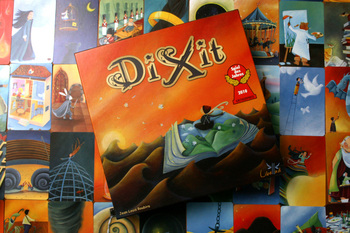
Mike Hulsebus | Contributor
Dixit is the board game that won Game of the Year last year in Germany. While that’s great for Dixit (and, I’m sure, its sales numbers), I feel like there is no better accolade for a game than for someone to play it and then for someone to say, “That was great, we should buy this” — something a friend of mine said after her first play.
For today’s review, we’ll go through one or two sample hands of Dixit to get a feel for the flow of play and see what makes this clue-giving art game such a hit. I’ll also use the phrase “gutting deer” for the first time in a review, so if you’ve been waiting for that moment, today is your day.
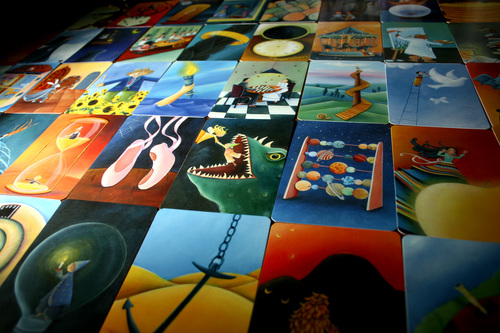
A small portion of the cards used in Dixit. Each of the cards features original art by Marie Cardouat
Mike Hulsebus | Contributor
In Dixit, players get a hand of six oversized cards, each with a drastically different painting on it. I don’t know how the artist came up for the ideas for these paintings. I imagine it had something to do with spinning a giant wheel of random words. How else would you think to an anchor sitting in a desert, ants sword fighting, or a person standing back-to-back with a human-sized teddy bear?
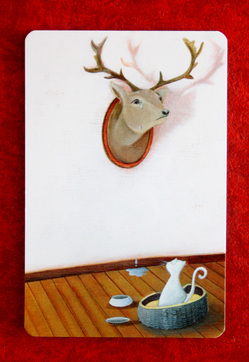
When it’s your turn, you are “the storyteller” and you choose a card from your hand and give a clue. The object is to give a clue that at least one player will understand, but not everyone. So say that I put the deer head picture face down. I might say “a knife with a hook in the top” and hope that someone at the table would know that some knives have hooks in them for when you are gutting deer. My clue can be a word or a whole sentence and doesn’t necessarily have to be so morbid. I could have said something referencing Bambi (especially since the deer is crying), but that likely would have been too obvious: remember I don’t want everyone to know which card I played, and I don’t want no one to guess which card I played: someone needs to understand what I mean.
After I have placed my card, everyone else gets a chance to add their own card to the middle face down. They are trying to trick the other players by putting down a card that might be described by my clue “a knife with a hook in the top.”
Then, we shuffle the cards and reveal them face up and put numbers next to them. Let’s see what the other players put down.
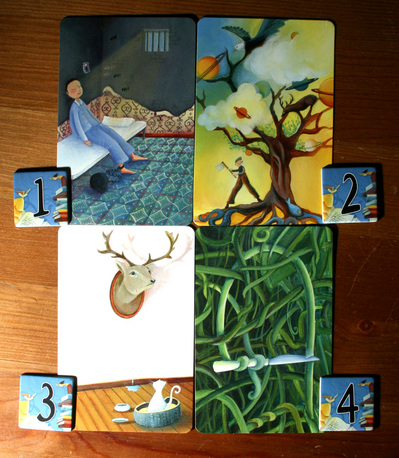
Mike Hulsebus | Contributor
Now, all of the players (other than myself, the storyteller) take a guess at which picture is mine by selecting and simultaneously revealing a numbered tile corresponding to their guess.
In this particular instance, it so happened that no one picked my deer head picture because, as you can see, someone played a picture that had a knife and that had a hooked vine at the top of the card. What are the chances, huh? In this instance, I would score 0 points as storyteller since no one guessed my card. Every other player earns 2 points and gets a bonus point for every vote that someone put on their card (and no, you can’t vote for yourself).
Let’s play another hand. Everyone starts by drawing back up to six cards. The storyteller then plays a card face down and gives a clue by singing, “To make me fret, to make me frown.” We would look our hand and decide which card might throw everyone else off the trail of the true card.
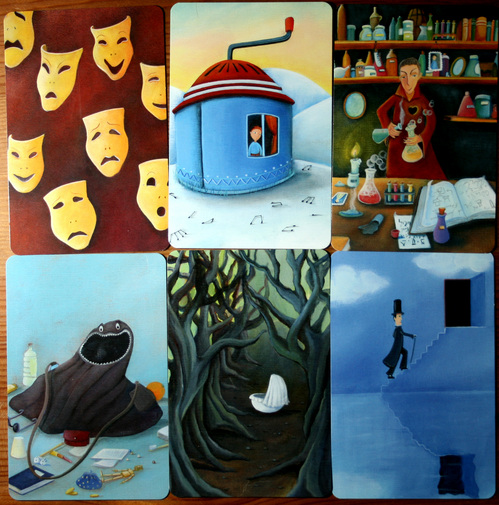
Mike Hulsebus | Contributor
Here is our hand. Let’s pick the one with the drama masks since one of the masks is frowning. Yes the one with the funny monster is great, but let's go with the drama masks. We put in our card and everyone’s cards get shuffled and numbered. Everyone votes on which card they think the storyteller put in. Make your guess before scrolling down completely: the answers are below the photo.
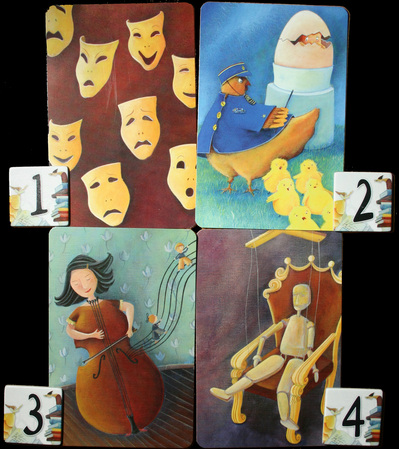
Mike Hulsebus | Contributor
We know, of course, that the storyteller didn’t put in the drama mask one so we can eliminate voting on that one. If we had remembered that “to make me fret, to make me frown” was a line from Pinocchio, we would guess the marionette option by putting in our tile of that number. Next comes scoring.
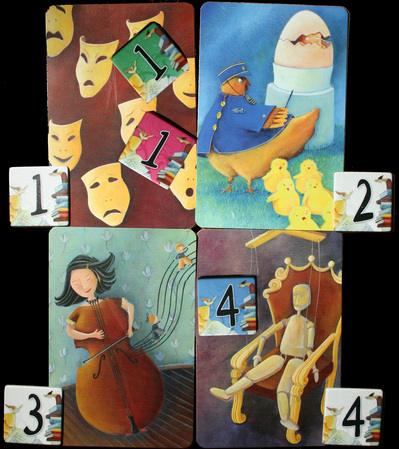
Mike Hulsebus | Contributor
We tricked everyone! Because the storyteller got at least one person to guess his card but not everyone, he scores three points, as does everyone that guessed it (just us!). We also score an extra point for each person that we tricked with our card. Everyone that guessed incorrectly scores 0 points, plus a bonus point for each person that they tricked (in this case, no one).
Dixit is a fun activity. I say “activity” rather than “game” because, to me, the scoring seems pretty inconsequential. Really, the scoring just serves as a framework to go through the cards while giving good-but-not-too-obvious clues. Scoring seems mostly as a clock put on the game to let you know how long you should play. Sometimes, when giving clues, I feel as if I could just as well pick clues quickly like, in “rack” in the first example and that, because of how many cards there are, someone is going to have something in their painting that will trick someone into picking their card (someone might say “oh, I thought maybe you were referring to the rack of potions on the other card”).
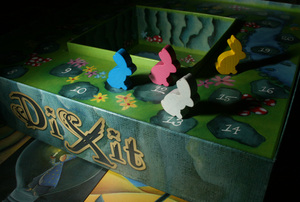
The track running around the inside of the box is used for scoring.
Mike Hulsebus | Contributor
What I mean to say is, it can feel like there is some degree of powerlessness you have over your score, no matter how much you thought about the clue you were going to give. Similarly, you find yourself at least once feeling like any card could be the storyteller’s card, and so you just guess randomly and hope you’re right.
Of course, to be fair, it’s possible that I’m just not very good at giving or guessing clues.
But again, I think Dixit is a fun activity, and so if you play to have fun rather than trying to maximize your point potential, I think you’ll be pleased with the game. Play to win, yes, but mostly play to have fun. If the game ends and you’ve won, great. If not, great; you still had fun giving clues and guessing cards.
The bizarre art of Dixit is what makes the game fun. Each of the paintings has so much happening in them that there are a lot of different things you could latch onto when giving clues. You could give a clue that is a reference to a small detail in the picture. You could give a clue about the sort of feeling that the picture evokes. You could make an allusion to a book or movie. You could say something that you think someone in the painting might say.
Dixit makes for a great party game. By now, you’re well aware of my favorite group/party games and the purposes they serve depending on the group.
No Thanks: An easy card game with lots of interesting strategy
Wits and Wagers: If I want trivia game with no need to trivia knowledge
Time’s Up: If I want something that’s sillier with acting and describing people on cards to your team.
And now I can add Dixit to the list. It doesn’t really fit well into a category (a pretty pictures game? A think-up-a-clue game?), but Dixit is game that I would feel confident bringing out with any group, knowing that people will probably have a good time. It’s not my Game of the Year, but I can definitely see why it was deserving of winning Game of the Year for sure.
Mike Hulsebus will save you a trip to Google and tell you that “Dixit” seems to be Latin for “an utterance”. He can be reached at mikehulsebus@gmail.com and would love to hear about games that you played knew you had to have right away.


Comments
Aturen
Sat, Jul 9, 2011 : 4:46 a.m.
I *LOVE* the art from this game! Does anyone know how I can buy prints and/or posters?!?